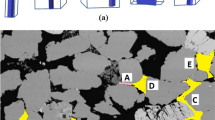Abstract
Rapid gas depressurization leads to gas cooling followed by slow gas warming when the cavern is kept idle. Gas temperature drop depends upon withdrawal rate and cavern size. Thermal tensile stresses, resulting from gas cooling, may generate fractures at the wall and roof of a salt cavern. However, in most cases, the depth of penetration of these fractures is small. These fractures are perpendicular to the cavern wall. The distance between two parallel fractures becomes larger when fractures penetrate deeper in the rock mass, as some fractures do not keep growing. These conclusions can be supported by numerical computations based on fracture mechanics. Salt slabs are created. However, these slabs remain strongly bounded to the rock mass and it is believed that in many cases their weight is not large enough to allow them to break off the cavern wall. Depth of penetration of the fractures must be computed to prove that they cannot be a concern from the point of view of cavern tightness.




Similar content being viewed by others
References
ATG (1986) Stockages souterrains de gaz (Underground gas storages). Manuel pour le transport et la distribution du gaz, Titre XIII. Association technique de l’industrie du gaz en France, 62 rue de Courcelles, 75008 Paris France (In French)
Baar CA (1977) Applied salt-rock mechanics. Vol. I. Developments in geotechnical engineering. Elsevier Science, Amsterdam
Bahr HA, Weiss HJ, Bahr U, Hoffmann M, Fischer G, Lamperscherf S, Balke H (2010) Scaling behavior of thermal shock crack patterns and tunneling cracks driven by cooling or drying. J. Mech. Ph. Solids 58(2010):1411–1421
Bérest P, Ghoreychi M, Fauveau M, Lebitoux P (1986) Mechanism of creep in gas storage caverns. Effect of gravity forces. In: Hartman HL (ed) Proceedings of the 27th US symposium on Rock Mech. Soc. Min. Eng. Inc., Littleton, Colorado, pp 789–794
Bérest P, Djizanne H, Brouard B, Hévin G (2012) Rapid depressurizations: can they lead to irreversible damage?. SMRI Fall Meeting, Regina, pp 64–83
Boucly Ph., Legreneur J. (1980) Hydrocarbon storage in cavities leached out of salt formations. In: Proceedings of the international symposium subsurface space. Stockholm, Sweden, pp 251-257
Brouard B, Karimi-Jafari M, Bérest P (2007) Onset of tensile effective stresses in gas storage caverns. SMRI Fall Meeting, Halifax, pp 119–135
Brouard B, Frangi A, Bérest P (2011) Mechanical stability of a cavern submitted to high-frequency cycles. SMRI Spring Meeting, Galveston, pp 99–116
Coates GK, Lee CA, McLain WC, Senseny PE (1983) Closure and collapse of man-made cavities in salt. In: Proceedings of the 6th international symposium salt, pp 139–157
Cole R (2002) The long term effects of high pressure natural gas storage on salt caverns. SMRI Spring Meeting, Banff, pp 75–97
Crossley NG (1996) Salt cavern integrity evaluation using downhole probes. A transgas perspective. SMRI Fall Meeting, Cleveland, pp 21–54
Crotogino F, Mohmeyer KU, Scharf R (2001) Huntorf CAES: more than 20 years of successful operation. SMRI Spring Meeting, Orlando, pp 351–362
Fosse AP, Røvang LB (1998) Verifying established initial gas temperature distribution in caverns. SMRI Spring Meeting, New Orleans, pp 126–142
Hévin G, Caligaris C, Durup JG (2007) Deep salt cavern abandonment: a pilot experiment. SMRI Fall Meeting, Halifax, pp 16–25
Klafki M, Wagler T, Grosswig S, Kneer A (2003) Long-term downhole fibre optic temperature measurements and CFD modeling for investigation of different gas operating modes. SMRI Fall Meeting, Chester, pp 180–189
Kneer A, Irmer A, Riegel H, Klafki M (2002) Application of a CFD-Code for modeling of 3-D processes in salt caverns during gas withdrawal. SMRI Fall Meeting, Bad Ischl, pp 197–209
Krieter M, Hagoort J, Barnewold D (1998) Thermodynamic simulation of gas caverns for optimized production management. SMRI Fall Meeting, Roma, pp 309–325
Krieter M (2011) Influence of gas cavern’s surface area on thermodynamic behaviour and operation. SMRI Fall Meeting, York, pp 179–184
Munson DE, Ehgartner B, Bauer S, Rautman C, Myers R (2004) Analysis of a salt fall in Big Hill Cavern 103, and a preliminary concept of salt dome structure. SMRI Spring Meeting, Wichita, pp 57–72
Nemat-Nasser S, Keer LM, PanharK S (1978) Unstable growth of thermally induced interacting cracks in brittle solids. Int J Solids Struct 14:409–430
Pellizzaro C, Bergeret G, Leadbetter A, Charnavel Y (2011) Thermomechanical behavior of stublach gas storage caverns. SMRI Fall Meeting, York, pp 161–178
Quast P (1983) L’installation de Huntorf: plus de trois années de fonctionnement de cavernes à air comprimé. Annales des Mines 190(5–6), 93–102 (In French)
Röhr HU (1974) Mechanical behavior of a gas storage cavern in evaporitic rocks. In: Coogan AH (ed) Proceedings of the 4th symposium on salt. Salt Institute, II, pp 93–100
Rokahr R, Staudtmeister K, Zander-Schiebenhöfer D, Johansen JI (2007) In-situ test with a gas storage cavern as a basis for optimization. SMRI Spring Meeting, Basel, pp 84–97
Serata S, Cundey TE (1979) Design variables in solution cavities for storage of solids, liquids and gases. In: Proceedings of the 5th symposium on salt. The Northern Ohio Geological Society Inc. Pub., pp 161–170
Skaug N, Ratigan J, Thompson M (2010) Natural gas cavern inventory assessment—a new approach. SMRI Spring Meeting, Gd Junction, pp 303–312
Wallner M, Eickemeier R (2001) Subsidence and fractures caused by thermo-mechanical effects. SMRI Spring Meeting, Orlando, pp 363–371
Zapf D, Staudtmeister K, Rokahr RB (2012) Analysis of thermal induced fractures in salt. SMRI Spring Meeting, Regina, pp 47–62
Acknowledgments
This study was funded partially by the French Agence Nationale de la Recherche (ANR) in the framework of the SACRE Project, which includes researchers from EDF, GEOSTOCK, PROMES (Perpignan), HEI (Lille) and Ecole Polytechnique (Palaiseau).
Author information
Authors and Affiliations
Corresponding author
Rights and permissions
About this article
Cite this article
Bérest, P., Brouard, B., Djakeun-Djizanne, H. et al. Thermomechanical effects of a rapid depressurization in a gas cavern. Acta Geotech. 9, 181–186 (2014). https://doi.org/10.1007/s11440-013-0233-8
Received:
Accepted:
Published:
Issue Date:
DOI: https://doi.org/10.1007/s11440-013-0233-8




